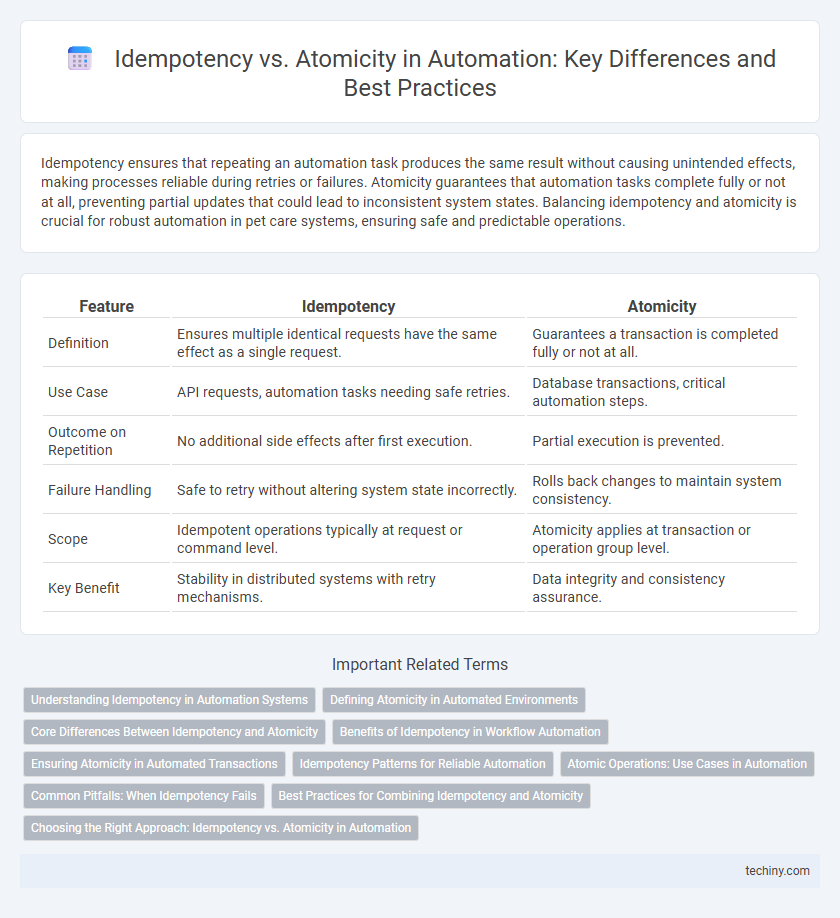Idempotency ensures that repeating an automation task produces the same result without causing unintended effects, making processes reliable during retries or failures. Atomicity guarantees that automation tasks complete fully or not at all, preventing partial updates that could lead to inconsistent system states. Balancing idempotency and atomicity is crucial for robust automation in pet care systems, ensuring safe and predictable operations.
Table of Comparison
| Feature | Idempotency | Atomicity |
|---|---|---|
| Definition | Ensures multiple identical requests have the same effect as a single request. | Guarantees a transaction is completed fully or not at all. |
| Use Case | API requests, automation tasks needing safe retries. | Database transactions, critical automation steps. |
| Outcome on Repetition | No additional side effects after first execution. | Partial execution is prevented. |
| Failure Handling | Safe to retry without altering system state incorrectly. | Rolls back changes to maintain system consistency. |
| Scope | Idempotent operations typically at request or command level. | Atomicity applies at transaction or operation group level. |
| Key Benefit | Stability in distributed systems with retry mechanisms. | Data integrity and consistency assurance. |
Understanding Idempotency in Automation Systems
Idempotency in automation systems ensures that repeated execution of the same operation produces the same result without unintended side effects, enhancing reliability and fault tolerance. This characteristic is critical in scenarios like network requests, job scheduling, and state management where duplicate actions must not alter the system's state beyond the initial application. Understanding idempotency enables automation developers to design robust workflows that handle retries gracefully and maintain consistent system behavior.
Defining Atomicity in Automated Environments
Atomicity in automated environments ensures that a sequence of operations executes fully or not at all, preventing partial completion that could lead to inconsistent states. This principle guarantees that automated workflows maintain data integrity by treating actions as indivisible units, critical in transaction processing and error handling. Implementing atomicity reduces system failures and simplifies rollback mechanisms, enhancing reliability in automation frameworks.
Core Differences Between Idempotency and Atomicity
Idempotency ensures that multiple identical requests produce the same result without additional side effects, enabling safe retries in automation processes. Atomicity guarantees that a series of operations within a transaction completes entirely or not at all, maintaining system consistency during task execution. The core difference lies in idempotency managing repeatable action outcomes, while atomicity manages transaction integrity.
Benefits of Idempotency in Workflow Automation
Idempotency in workflow automation ensures that repeated execution of a task produces the same result without unintended side effects, significantly increasing system reliability and reducing error handling complexity. It enables safe retries and fault tolerance, allowing workflows to recover seamlessly from interruptions or failures. This leads to improved consistency and efficiency in automated processes, minimizing the risk of duplicate operations or data corruption.
Ensuring Atomicity in Automated Transactions
Ensuring atomicity in automated transactions requires that each operation is completed fully or not executed at all, preventing partial updates that could lead to inconsistent system states. Techniques such as transactional locks, rollback mechanisms, and integrity constraints support atomicity by maintaining data accuracy and system reliability. Unlike idempotency, which allows repeated operations without additional effects, atomicity guarantees the indivisibility of complex processes in automation workflows.
Idempotency Patterns for Reliable Automation
Idempotency patterns ensure reliable automation by allowing repeated execution of operations without causing unintended side effects, which is crucial for handling network retries and system failures gracefully. Implementing unique request identifiers and maintaining operation logs help prevent duplicate processing and data corruption. These strategies enable automated systems to maintain consistency and reliability across distributed environments.
Atomic Operations: Use Cases in Automation
Atomic operations ensure complete execution of tasks without partial changes, making them essential for reliable automation workflows. In automation, atomicity prevents inconsistent states during system updates, such as database transactions or configuration management. Implementing atomic operations reduces errors and maintains data integrity when automating critical processes like deployment pipelines or transaction processing.
Common Pitfalls: When Idempotency Fails
Idempotency in automation fails when system states are not properly tracked, leading to repeated operations causing inconsistent results or resource duplication. Race conditions and insufficient state management often cause non-idempotent behavior, making recovery and retries problematic. Ensuring atomicity in critical operations prevents partial updates, but overlooking idempotency mechanisms can still result in data corruption or unintended side effects during automation retries.
Best Practices for Combining Idempotency and Atomicity
Combining idempotency and atomicity in automation ensures reliable and consistent system behavior by preventing duplicate operations and guaranteeing complete transaction execution. Implement best practices such as using unique request identifiers for idempotent operations and enforcing atomic transactions through database locking or transactional APIs. Monitoring and logging each operation enhance fault tolerance and aid in troubleshooting, ensuring seamless integration of idempotency and atomicity principles.
Choosing the Right Approach: Idempotency vs. Atomicity in Automation
Choosing the right approach between idempotency and atomicity in automation hinges on the desired outcome for task execution reliability and error handling. Idempotency ensures that repeated executions result in the same state without side effects, crucial for systems requiring consistent integrations and retries. Atomicity guarantees complete success or full rollback in transactional processes, essential for maintaining data integrity in complex, multi-step automation workflows.
Idempotency vs Atomicity Infographic

 techiny.com
techiny.com